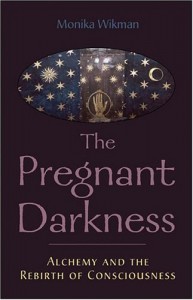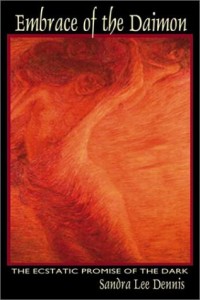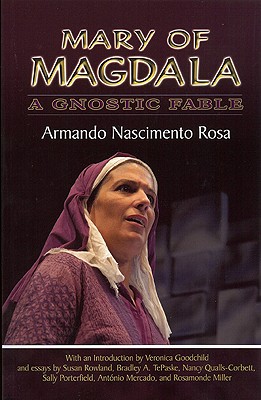Mary of Magdala is inspired by a dissident Christian legend that had its origins in Provence. The drama takes place one night in the year 54 A.D., in Marseille, when Mary’s voice is being isolated in a Church where the doctrine of Paul of Tarsus increasingly helps blot out the important role played by female preachers during the first two centuries of the Christian era. The play portrays the clash between an alternative religious experience at the roots of Christendom, personified in Mary of Magdala, and an official dogmatism that predicts the marriage of convenience between the Roman Empire and the Roman Church. This is the first publication of the play in English.
Book Review: Pregnant Darkness by Monika Wikman
Review by Veronica Goodchild, August 2008 for Spring Journal
Monika Wikman, Pregnant Darkness: Alchemy and the Rebirth of Consciousness.
 A rare sensibility inhabits the pages of Jungian Analyst Monica Wikman’s alchemical book, which makes it compelling for both seasoned clinician and interested layperson alike. Wikman explores the psychological/somatic processes of death and rebirth based on Jung’s alchemical model of the psyche and breathes new life into this model with contemporary clinical examples and some deeply moving dreams illustrating her themes throughout the text.
A rare sensibility inhabits the pages of Jungian Analyst Monica Wikman’s alchemical book, which makes it compelling for both seasoned clinician and interested layperson alike. Wikman explores the psychological/somatic processes of death and rebirth based on Jung’s alchemical model of the psyche and breathes new life into this model with contemporary clinical examples and some deeply moving dreams illustrating her themes throughout the text.
I was immediately struck by the title of this book. Both the ‘Pregnant’ and the ‘Darkness” suggested an emphasis not only on the processes of transformation rather than some end result, but also the importance of descent and the dark night of the soul as indispensable for the renewal of life energy and creativity, and for which Jung’s psychology provides such a unique context.
Wikman’s book begins with her own brief account of her spontaneous and immediate healing of an aggressive stage IV ovarian cancer that she had suffered with for over four years and that had almost killed her. At the moment when the illness was finally declared terminal, she let go and surrendered to death, but not before raging at the universe for her profound disappointment and despair. This painful lament or heart felt confession opened up a series of visions that Wikman refers to as taking place in the psychoid realm, an intensely felt psycho-physical level of consciousness beyond the collective unconscious. Jung began to name and explore this psychoid realm when he was forced to revise his notion of the archetype with experiences of synchronicity and other paranormal phenomena, but this late work of Jung’s has not been moved forward significantly by many Jungian scholars or analysts. Wikman bravely pursues and explores the intense landscapes of this psychoid realm that she knows first hand from her experience of them. Apart from Jung’s own visionary and imaginal experiences recorded mainly in Memories, Dreams, Reflections, the theologian and philosopher Henri Corbin perhaps comes closest to these domains when he describes the real (not fictive or imaginative) landscapes of the soul as psycho-cosmic imaginal geographies. In my view, Jungian psychology has neglected the reality of the imaginal domains in favor of an emphasis on symbolic interpretations, so it is refreshing to read Wikman’s own and her patients’ accounts of such subtle body experiences and their central place in the processes of initiation and transformation.
Wikman’s contribution to our understanding of alchemy, therefore, is firmly grounded in the psyche-matter mysteries that so preoccupied the alchemists and for which the traditions of alchemy and the alchemical processes of transformation and transmutation provide a symbolic and experiential system. The recognition of the divine inhabiting the soul in the human physical body is at the center of this mystery and its exploration at the heart of its teachings. Pregnant Darkness is divided into two parts tracing the initiate’s journey into this profound mystery. Part One, “The Nigredo and the Rising of Lunar Consciousness,” is a journey to the source of living waters. Through acknowledging and opening to our wounds we experience a shamanic death—the alchemical nigredo—and open to the heavens and hells of deep subjectivity and archetypal reality; not, as Wikman writes, a journey for the faint-hearted. Here, Wikman, following Jung, stresses the importance of the human relationship between analyst and analysand over theoretical constructs as the necessary container for psychological dismemberment and the terrors of insanity that often accompany these darknesses and conflicts. A favorite clinical example in this part of the book is of a woman whose over-identification with independence and achievement led her away from her own feminine nature and instincts. Eventually a dream vision of an illuminated fairy queen arising out of the earth with other fairies all sitting on dew drops on blades of grass which become crowns, leads to an experience of the healing light to be found within nature herself. The woman “felt the experience of the divine incarnating into matter” (pp. 55-62). Wikman masterfully amplifies the details of the dream vision noting especially the four main problems that Marie-Louise von Franz suggests alchemy addresses to help us all deal with the limitations of our Christian mythic inheritance: the value of the feminine erotic mystery; the elevation of the individual in relation to the uniformity of the mass; the problem of evil; and the reconciliation of opposites. An essential focus in Part One of the book is how the nigredo leads to the development of a religious attitude that comes with exposure to the dark subtle depths of the soul.
Part Two, “The Albedo & Rubedo: Rebirth of Consciousness, Shining Renewed,” focuses on how the development of a religious attitude needs to be sustained by daily practice and dialogue with the unknown mysteries of the psyche as they appear in dream, vision, encounter, and relationship—relationship with others as well as in our experiences of nature. Wikman addresses both resistances to this process and the dangers of approaching transpersonal forces with the ego inflation that can result. She also witnesses the healing restoration and renewal of freedom and life that our odysseys can awaken for us. One of the things I found to be most valuable in this part of the book is the author’s focus on how the religious attitude finds its true home in the awakening of the heart and the development of our capacity to love. Insight and conscious realization are steps along the way but not the telos of the alchemical opus. Rather, individuation is a process of moving from understanding with the mind to embodying the felt instincts of the heart and this is one way in which the divine seeks to manifest in the human soul. Wikman writes: “The mental work and understanding feeds another mystery, the mystery of the heart, where the being of light resides” (p. 161). Alchemical work changes us and these changes must inform the way we live with ourselves, with others, with the divine and the world around us. In other words, the processes of transformation bring up the ethical consideration of how to live from the perspective of the wisdom revealed from the deep psyche.
Another important contribution in Part Two is how we discover what Wikman, following Jeff Raff, calls the Ally or Guide from the psychoid dimension of the psyche. Through the example of a patient who had had abdominal surgery early in life that led to her inability to bear children, and her powerful dream and active imagination, Wikman shows “the immediate experience of the divine in relationship with the generative psychic-emotional-physical wound, and in relationship with the path of individuation” (p. 186). We read how in the dream the patient’s body becomes the landscape of earth, and how her belly becomes a lotus with water in the middle that draws the divine figure from the sky world through love and mutuality. Dreaming the dream forward in active imagination, the patient experiences a beneficent snake-like dragon lover that descends from the cosmos beyond our known galaxy and opens her belly revealing it to be like the mythic crack in the earth between the worlds in Celtic mythology. Her “being open to cracking open” also cracks open the sky allowing this guide to descend to earth. The ally reveals himself to be a fierce protector of all that she loves and of her particular path in life. She feels an ecstatic exchange of breath with this companion-lover, a breath that melts away all cares and falsities bringing a “profound communion between cosmic being and human being” that awakens her soul and simple humanity. Furthermore, Wikman’s example also demonstrates how our connection through our own woundings with the divine, personified as protector and companion, not only helps transform us but also helps transform the divine as well, in this case revealing how the god-image is changing in the patient’s life. This deep connection to the guide gives us the confidence to sacrifice outworn modes of being and to become more real and to foster our lives as “carriers of living water” so central to alchemy. Furthermore, this spiritual contact gives rise to a deep erotic instinctual part of the psyche that with awareness can regulate both rapport and distance in our relationships and, as an inner helper, fuels our capacity for spontaneity, vitality and creativity (pp. 185-188).
We live at the end of an age and see death and destruction all around us. However, at the same time, we also live at a time when profound unitive levels of experience are arising in the human soul as well as in nature. For example, on the collective level, I have long been intrigued with how these psychoid levels of the world soul seem to be manifesting as ‘new creations’ in the universal form of UFOs (from above) and Crop Circles (from below) initiating dramatic changes in consciousness for those who take such events seriously. These manifestations are not only symbolic of the emerging unity of psyche and matter (which they are) but they are also real expressions of the psychoid archetype. It appears as if what the alchemists called the unus mundus or one world is constellating today in an attempt to reconcile opposites and to seek balance away from divisive and devastating conflicts toward healing, wholeness, and Eros consciousness. Wikman’s book assists us in recognizing and contributing toward this healing and wholeness in the individual human soul. Following the ancient alchemical mysteries, she shows us how the imaginatio vera—the true, spiritual or visionary imagination—is the organ of knowledge located in the heart, that assists in co-creating a new level of consciousness beyond opposites through direct experiences of the psychoid world. Such subtle experiences from beyond the archetypal domains give us glimpses into an interconnected and multidimensional universe fashioned by the deep mysteries of love.
Veronica Goodchild, PhD, is a professor of Jungian and Imaginal Psychology at Pacifica Graduate Institute. She has been a Jungian psychotherapist for over twenty-five years. She is the author of Eros and Chaos: The Sacred Mysteries and Dark Shadows of Love (Nicolas-Hays, 2001), and The Songlines of the Soul: A New Vision for a New Century, that explores the implications of Jung’s psychoid archetype from synchronicity to UFOs and Crop Circles, and further to the mystical cities of the soul.
Book Review: Embrace of the Daimon by Sandra Dennis
Review by Veronica Goodchild, February 6, 2013
Sandra Dennis, Embrace of the Daimon: Healing Through the Subtle Energy Body in Jungian Psychology .
 We speak more urgently today of a mind-body connection as psyche truly seeks to incarnate in and through us beyond anything we might say or interpret about her. In this unique, engaging work, Sandra Dennis goes beyond the split that continues to underlie the phrase ‘mind-body’. Building on the alchemical notion that she calls the unio corporealis (‘union with the body’), first identified by Jung, she takes us on a journey to the profound levels of subtle body reality in that landscape of the psychoid that Corbin calls the imaginal world.
We speak more urgently today of a mind-body connection as psyche truly seeks to incarnate in and through us beyond anything we might say or interpret about her. In this unique, engaging work, Sandra Dennis goes beyond the split that continues to underlie the phrase ‘mind-body’. Building on the alchemical notion that she calls the unio corporealis (‘union with the body’), first identified by Jung, she takes us on a journey to the profound levels of subtle body reality in that landscape of the psychoid that Corbin calls the imaginal world.
Pressing up from a realm that is neither spirit nor matter, yet paradoxically psychophysical in nature, the daimons and guides from this realm are seeking connection and transformation with our co-participation, in order to enable both consciousness and matter to evolve to a higher level. Increasingly we hear about what I call signatures of this new emerging subtle realm coming back into prominence in our time – from synchronicities, kundalini openings, shamanic and near-death experiences, to UFO encounters and the mysteries of crop circle manifestations – as spirit and matter reach toward each other for a new Sacred Marriage in the realm of psyche.
This book helps us learn to recognize and navigate this subtle, imaginal realm and its denizens, and to heal through its often taboo energies, associated with the presence of feminine wisdom as Sophia, and engages us at the leading radical edge of Jungian psychology today.
Veronica Goodchild, PhD, Core Faculty, Jungian and Imaginal Psychology, Pacifica Graduate Institute, author of Eros and Chaos: The Sacred Mysteries and Dark Shadows of Love (2001, 2008), and Songlines of the Soul: Pathways to a New Vision for a New Century (2012).
Eros and Chaos: The Sacred Mysteries and Dark Shadows of Love

Eros and Chaos: The Sacred Mysteries and Dark Shadows of Love is a provocative book that reminds us that our soul’s primary longing is for love and then explores that longing.
Veronica Goodchild explains that our most important task is the growth of our consciousness and that this cannot be accomplished apart from an awareness of the complexities of love and its shadows. It takes the reader into that domain where eros’ arrows thrust us into those shadowy depths where our keenest vulnerabilities and woundings and our deepest imaginings and longings are hidden.
Praise
“This book grows out of a fully embodied, compelling, passionate, profoundly personal, richly imagined, reflective and visionary engagement with its theme, the inescapable connection between Eros and Chaos, love and its wounds, both given and received. Veronica Goodchild has learned that these wounds, painful and unwelcome as they may be, can nevertheless be what opens us to the divine.”
– Christine Downing, author of The Goddess and The Long Journey Home and many other writings.
“With threads of Jungian thought, mythology, poetry, and unique personal experiences, Veronica Goodchild weaves an exploration into the interrelated dynamics of Eros and Chaos, not only in the universe, but in one’s personal psychology – a microcosm within a macrocosm. An engaging book!”
– Nancy Qualls-Corbett, Jungian Analyst and author of The Sacred Prostitute.
“Veronica Goodchild honors the mystery of dream-vision and synchronicity. She explores the fierce truth of how the shadow side of Eros refreshes soul-growth and, like a Renaissance alchemist, she calls for an inner science and art equal to the wonder and wildness of experience. I feel a profound creative urgency here.”
– Coleman Barks, author of The Soul of Rumi and many other works.
Songlines of the Soul: Pathways to a New Vision for a New Century

Praise
“There are certain moments in the history of cultures when changes in perception occur with such dramatic effect that one can speak of a paradigm shift out of which emerges a new way of understanding life, death and the meaning of both our personal and collective destiny. These are often times of great confusion as the old dies and the new only slowly reveals itself. At such times it is good to have a guide, and Veronica Goodchild presents herself in this book as a guide with a clear understanding of what must replace our old perceptions of the universe and our place within it. Combining deep insight into the nature of the new with examples from the lives of real people Veronica compiles an impressive overview of the direction of human evolution, as experiences of UFOs, synchronicities, crop circles and other forms of non-ordinary perception force us to reexamine the nature of the universe we live in. This book is a gift to those seeking to understand and to participate in the amazing diversity and richness of life on both the material and spiritual planes.”
—Dr. Jeffrey Raff, Author and Jungian analyst from Denver, Colorado.
Jung and the Alchemical Imagination (2000);
The Wedding of Sophia: The Divine Feminine in Psychoidal Alchemy (2003);
The Practice of Ally Work: Meeting and Partnering with Your Spirit Guide in the Imaginal Realm (2006).
“This truly wonderful book takes us into the new era announced by science with
the recent discovery of the Higgs Boson particle. Goodchild acts as guide, taking us beyond the limitations of rational thinking into unrecognized subtle dimensions of reality, helping us to reconnect with the forgotten pathways of the soul.”
—Anne Baring, Jungian Analyst, author of The Dream of the Cosmos: A Quest for the Soul and co-author of The Myth of the Goddess: Evolution of an Image
“A stunning achievement. I am on my second read through and still do not feel I have plumbed its depths. Here is a book that I resonate with so highly with that it has on occasion brought me to tears. It will now sit on a very special shelf in my bookcase with a small, but choice, selection of others that have become my indispensable guides to the birthing of this new state of consciousness through which we are all living.”
—Karen Alexander, co-author with Steve Alexander of Crop Circles: Signs, Wonders and Mysteries, and The Crop Circle Yearbooks
“Veronica Goodchild has written an important counter to the oppressive scientism that tends to silence our connection to dimensions of reality that are not readily amenable to empirical study. She shows us that there is a subtle More to reality than we have been led to believe, and she introduces us to these mysteries in a provocative and scholarly manner. As we read this book, the universe suddenly becomes deeper and more intriguing than we could have imagined.”
—Lionel Corbett, author of The Religious Function of the Psyche, Psyche and the Sacred, and The Sacred Cauldron: Psychotherapy as a Spiritual Practice
“As Veronica Goodchild picks up her alchemical stone, the veins in the stone come to life and her illumined eye and finely tuned mystical soul find their way to the page with these visionary mysteries, and Songlines of the Soul is born. An alchemical mystical treatise, Songlines takes us on an extraordinary journey into realms of the imaginal that expand our consciousness and our map of reality. Goodchild’s keen intelligence and visionary capacity hunt and track down patterns of fundamental mysteries about the nature of the psyche and psychoid that take us into phenomena on the edge of consciousness that knock at the doors of the known world : Mystical Cities, UFOs, crop circles to name a few. Anyone interested in depth psychology and the mysteries of our times will get a vast drink of the living waters of the psyche and psychoid with Songlines of the Soul, where Veronica’s work has driven a tap root down into this soul nourishing realm.”
—Monika Wikman Ph.D. Jungian analyst and author of Pregnant Darkness: Alchemy and the Rebirth of Consciousness
“Veronica Goodchild’s book Songlines of the Soul is the first book I know that speaks of the deeply emotionally touching and transmuting aspect of UFO phenomena. As she writes, every UFO encounter and ‘abduction’ is a call for initiation into the reality of the subtle body phenomenon neither explainable by natural science nor superficial psychology. We need a completely new worldview based on the reality of the unus mundus (C.G. Jung) or psychophysical reality (Wolfgang Pauli) to understand such phenomena. Today, in more and more people, this new worldview is constellated. To me, this is a great hope for our world in danger of being extinguished by our completely destructive behaviour.”
—Remo F. Roth, Author of Return of the World Soul (2011/2012).
“Veronica is [what I call] a reliable Witness. I learned about this term from a Catholic prelate at a conference in San Marino in April 1999, who reported that the Vatican takes UFO phenomena seriously because there are so many reliable Witnesses. The Church relies on this notion when evaluating miracles. The Witness is in a sacred tradition. The Zen master too speaks of the Witness as having a clarity of mind, is not attached to what they are saying, and a purity of expression. I feel my role is Witness to the Witnesses, helping to give them voice, asserting their reliability, giving them a chance to be heard, because they bring something of extraordinary importance to the culture, because they are receiving information from whatever source this phenomenon emanates from that says: human beings have to change; we have to open our consciousness, and stop the destructive path we are on. Veronica is such a Witness.”
—Dr. John Mack, Harvard psychiatrist, researcher of extraordinary experiences, and author of Passport to the Cosmos


